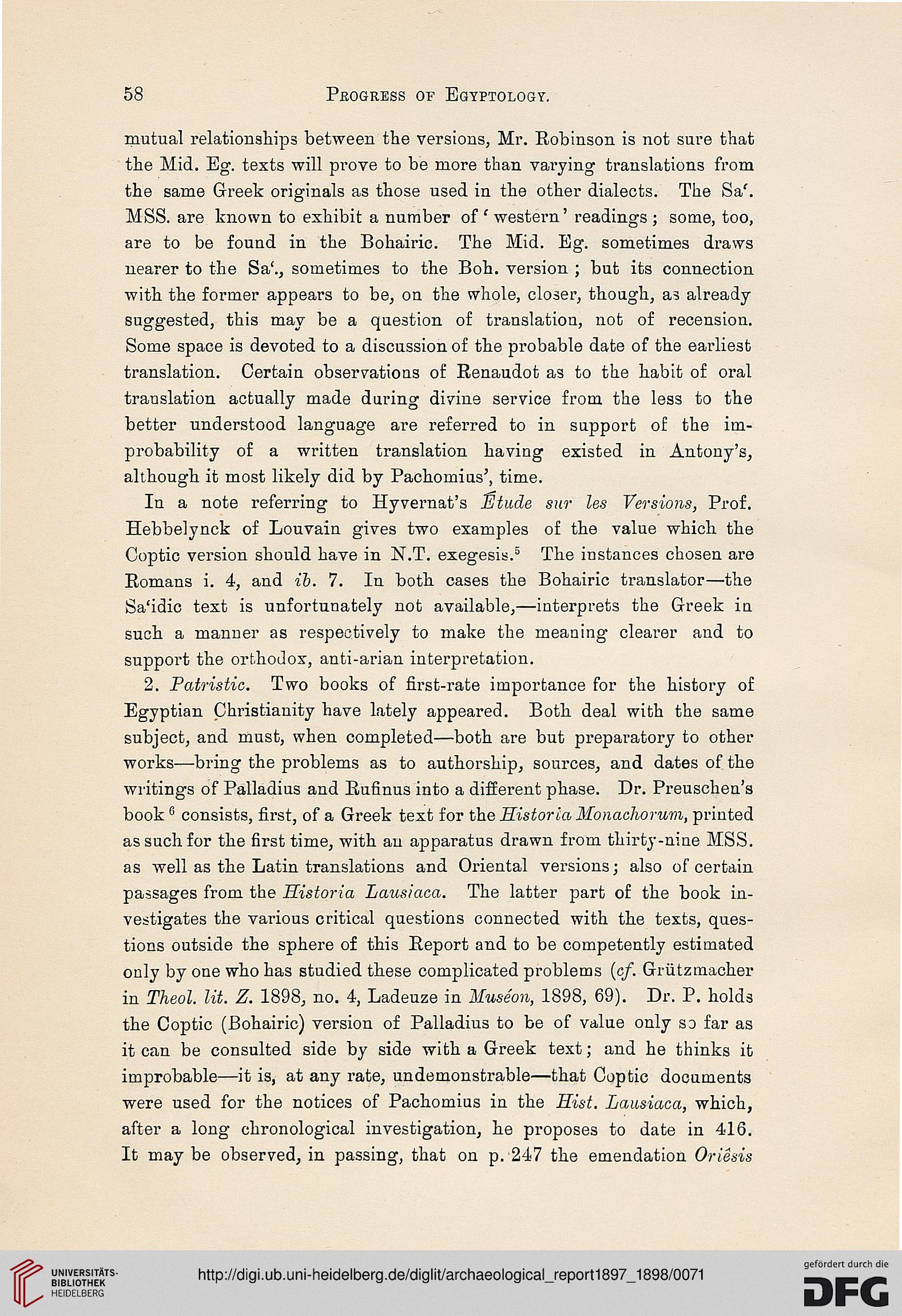5S
Progress of Egyptology.
mutual relationships between the versions, Mr. Robinson is not sure that
the Mid. Eg. texts will prove to be more than varying translations from
the same Greek originals as those used in the other dialects. The Sa'.
MSS. are known to exhibit a number of'western' readings; some, too,
are to be found in the Bohairic. The Mid. Eg. sometimes draws
nearer to the Sa'., sometimes to the Boh. version ; but its connection
with the former appears to be, on the whole, closer, though, as already
suggested, this may be a question of translation, not of recension.
Some space is devoted to a discussion of the probable date of the earliest
translation. Certain observations of Renaudofc as to the habit of oral
translation actually made during divine service from the less to the
better understood language are referred to in support of the im-
probability of a written translation having existed in Antony's,
although it most likely did by Pachonnus,) time.
In a note referring to Hyvernat's Etude sur les Versions, Prof.
Hebbelynck of Louvain gives two examples of the value which the
Coptic version should have in N.T. exegesis.5 The instances chosen are
Romans i. 4, and ib. 7. In both cases the Bohairic translator—the
Sa'idic text is unfortunately not available,—interprets the Greek in
such a manner as respectively to make the meaning clearer and to
support the orthodox, anti-arian interpretation.
2. Patristic. Two books of first-rate importance for the history of
Egyptian Christianity have lately appeared. Both deal with the same
subject, and must, when completed—both are but preparatory to other
works—bring the problems as to authorship, sources, and dates of the
writings of Palladius and Rufinus into a different phase. Dr. Preuschen's
book0 consists, first, of a Greek text for the Historia MonacJiorum, printed
as such for the first time, with an apparatus drawn from thirty-nine MSS.
as well as the Latin translations and Oriental versions; also of certain
passages from the Historia Lausiaca. The latter part of the book in-
vestigates the various critical questions connected with the texts, ques-
tions outside the sphere of this Report and to be competently estimated
only by one who has studied these complicated problems (cf. Griitzmacher
in Theol. lit. Z. 1898, no. 4, Ladeuze in Museon, 1898, 69). Dr. P. holds
the Coptic (Bohairic) version of Palladius to be of value only so far as
it can be consulted side by side with a Greek text; and he thinks it
improbable—it is, at any rate, undemonstrable—that Coptic documents
were used for the notices of Pachomius in the Hist. Lausiaca, which,
after a long chronological investigation, he proposes to date in 416.
It may be observed, in passing, that on p. 247 the emendation Oriesis
Progress of Egyptology.
mutual relationships between the versions, Mr. Robinson is not sure that
the Mid. Eg. texts will prove to be more than varying translations from
the same Greek originals as those used in the other dialects. The Sa'.
MSS. are known to exhibit a number of'western' readings; some, too,
are to be found in the Bohairic. The Mid. Eg. sometimes draws
nearer to the Sa'., sometimes to the Boh. version ; but its connection
with the former appears to be, on the whole, closer, though, as already
suggested, this may be a question of translation, not of recension.
Some space is devoted to a discussion of the probable date of the earliest
translation. Certain observations of Renaudofc as to the habit of oral
translation actually made during divine service from the less to the
better understood language are referred to in support of the im-
probability of a written translation having existed in Antony's,
although it most likely did by Pachonnus,) time.
In a note referring to Hyvernat's Etude sur les Versions, Prof.
Hebbelynck of Louvain gives two examples of the value which the
Coptic version should have in N.T. exegesis.5 The instances chosen are
Romans i. 4, and ib. 7. In both cases the Bohairic translator—the
Sa'idic text is unfortunately not available,—interprets the Greek in
such a manner as respectively to make the meaning clearer and to
support the orthodox, anti-arian interpretation.
2. Patristic. Two books of first-rate importance for the history of
Egyptian Christianity have lately appeared. Both deal with the same
subject, and must, when completed—both are but preparatory to other
works—bring the problems as to authorship, sources, and dates of the
writings of Palladius and Rufinus into a different phase. Dr. Preuschen's
book0 consists, first, of a Greek text for the Historia MonacJiorum, printed
as such for the first time, with an apparatus drawn from thirty-nine MSS.
as well as the Latin translations and Oriental versions; also of certain
passages from the Historia Lausiaca. The latter part of the book in-
vestigates the various critical questions connected with the texts, ques-
tions outside the sphere of this Report and to be competently estimated
only by one who has studied these complicated problems (cf. Griitzmacher
in Theol. lit. Z. 1898, no. 4, Ladeuze in Museon, 1898, 69). Dr. P. holds
the Coptic (Bohairic) version of Palladius to be of value only so far as
it can be consulted side by side with a Greek text; and he thinks it
improbable—it is, at any rate, undemonstrable—that Coptic documents
were used for the notices of Pachomius in the Hist. Lausiaca, which,
after a long chronological investigation, he proposes to date in 416.
It may be observed, in passing, that on p. 247 the emendation Oriesis





